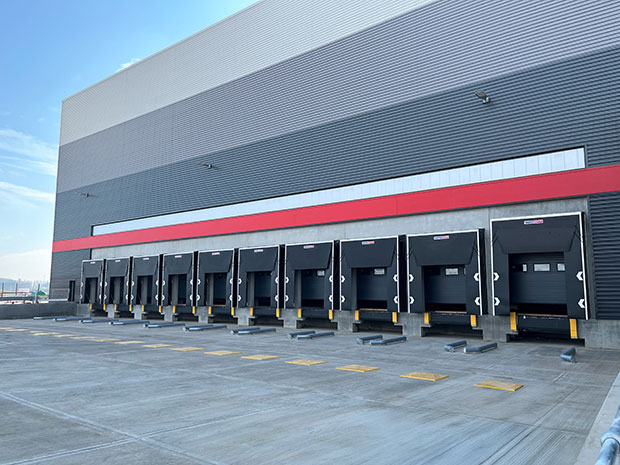When planning a new warehouse or logistics site, it’s easy to focus on headline features – square footage, clear internal heights, or BREEAM ratings. But one area that can make or break a facility’s long-term usability is often overlooked: the loading bay.

Whether you’re working on a build-to-suit facility, speculative unit, or multi-let site, getting the loading bay design right from the start can improve safety, operational flow, energy efficiency, and tenant satisfaction. But what exactly should you be thinking about?
Here are five key questions every project team should ask before specifying loading bay equipment:
1. What types of vehicles will be using the bays?
Vehicle type is one of the most important factors in loading bay design. Everything from leveller height and lip type to shelter and door dimensions hinges on the kind of vehicles that will be in operation, whether that’s vans, articulated lorries, double-deck trailers, or container vehicles.
If the site will serve a consistent fleet, a standardised bay design may be all that’s needed. But where mixed fleets or unknown occupiers are expected, flexibility becomes crucial. Telescopic lip levellers and adjustable shelters can accommodate different vehicle sizes without compromising performance.
2. Will the facility serve one tenant or multiple occupiers?
For known occupiers, loading bays can be tailored to a specific operational model. But speculative developments or multi-let units must appeal to a wider audience, and that calls for a more adaptable approach. Longer leveller platforms and shelters that work across a range of trailer heights all help ensure the facility is ready for a variety of uses. These decisions may not seem urgent early on, but they can have a real impact on letting speed and long-term value.
3. What level of traffic and loading intensity is expected?
Facilities with high throughput – such as retail distribution centres or parcel hubs – demand more than just durable equipment. Efficient layouts, smooth traffic flow, and reduced vehicle dwell time all contribute to performance.
That’s where thoughtful bay positioning and reliable equipment come in. Features like wheel guides, LED bay lighting, and heavy-duty bumpers help maintain safe, efficient operations. In fast-turnaround environments, flexible solutions like Stertil’s VARIFLEET® dock leveller are especially useful, allowing a wide range of vehicles to load and unload without delay.
4. Are there any specific sector or compliance requirements?
Different sectors often have very specific needs. Cold chain logistics, for example, require sealed loading systems to maintain internal temperatures, typically using insulated dock houses, inflatable shelters, and telescopic lip levellers.
Food or pharmaceutical distribution may need dock levellers and doors that minimise contamination risks, while some last-mile operations prioritise low-height bays suited to vans.
Understanding these needs at the design stage is critical. It ensures the building will perform as expected and prevents costly late-stage changes. With decades of experience across sectors, Stertil Dock Products can help you match equipment specifications to operational and compliance requirements from day one.
5. What level of support do you need?
Selecting the right supplier is about more than product delivery. The best partners support the project from early design stages through to final installation and beyond. That includes help with BIM coordination, technical drawings, product selection, and installation timing, all aligned to the wider programme.
Ongoing service and maintenance support can also make a difference after handover, giving peace of mind to both landlords and occupiers.
Getting It Right from the Start
Loading bays may only occupy a small part of the building, but they play a critical role in how the site operates. From efficiency and safety to tenant flexibility and long-term value, getting the spec right matters, and the earlier these conversations happen, the better the outcome. That’s why working with specialist loading bay equipment suppliers like Stertil Dock Products can make all the difference, providing expert guidance, technical insight, and a complete product range from day one.




Comments are closed.